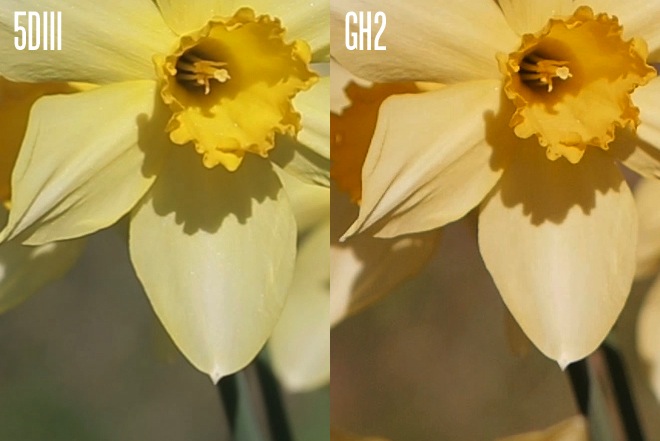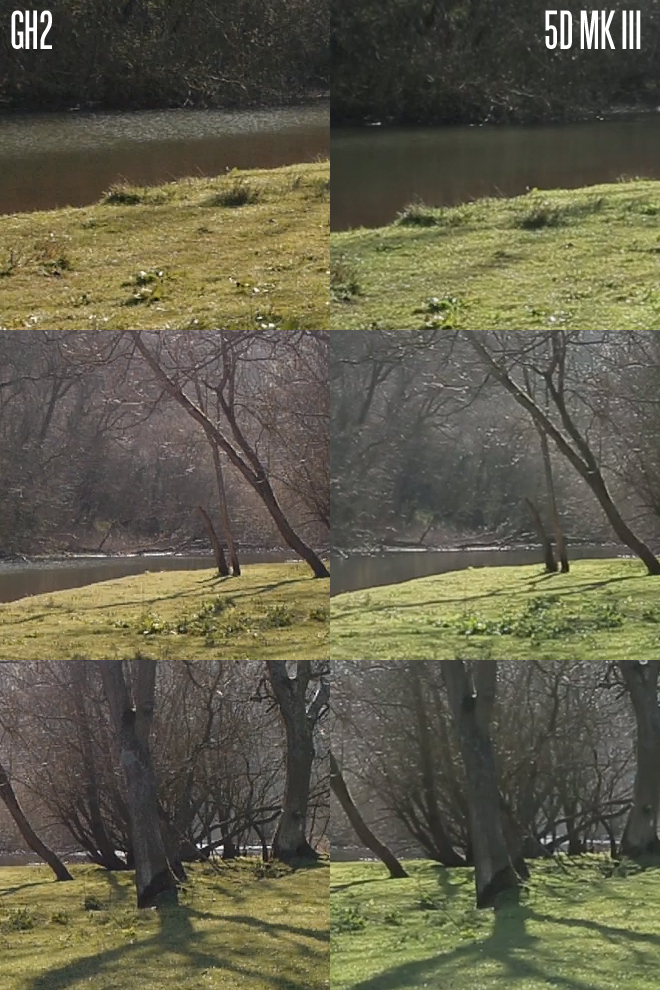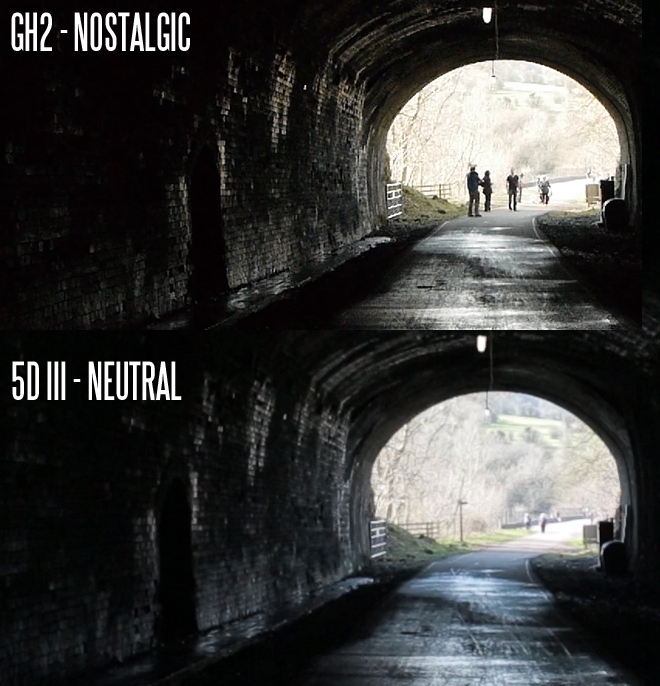Comment on this article at the EOSHD Forum
Click here to view the embedded video.
Today I shot this comparison between the 5D Mark III and hacked Panasonic GH2 with EOSHD Unified Patch. The results are all in the video.
Now you just need to factor in overall aesthetics to your decision, which are important. Personally I’d say that full frame sensor aside there is no reason why I like the 5D Mark III’s cinematic image more than the GH2’s. But I do need a full frame camera! It is another look, another option.
Overall the GH2 looks more like a digital form of Super 16mm with a fine grain and detailed image. It is also punchy and contrasty. With fast glass it has more of a dreamy Super 35mm look. The GH2’s sensor size is after all very close to motion picture Super 35mm, if not photographic 35mm. I am big on a fine grain of noise. Too clean and you get a plastic look, too blotchy at high ISOs and you get a very soft image. The noise grain on the GH2 is unusual for an H.264 based codec in that the high bitrates with the hack maintain a very fine grain structure like the broadcast MPEG codec on the Canon C300. The 5D Mark III is the opposite – a blotchy noise pattern and even a fizz at lower ISOs which is generated by the codec. Of course Canon could have put the XF’s lovely MPEG codec in there, but didn’t.
The 5D Mark III excels on skin tones, saturated colour and a shallower depth of field all else equal. Certain kinds of shot shows off the far superior sensor but mostly the 5D Mark III is extremely soft and finely textured grass or fabric viewed from a distance looks plastic.
The photographic 35mm sensor of the 5D Mark III allows you to isolate a subject from the background without resorting to a faster aperture and a closer focus distance, a technique sometimes needed with the GH2. This is a plus point but not as important to me as resolution. I’m not a major ultra-shallow DOF junkie and you can achieve that look on the GH2 to the same degree as you can on Super 35mm with most common shot set-ups with the right glass.
The 5D Mark III is an incredible stills camera and the sensor is much improved in low light. However the video image is not really an improvement on a nearly 4 year old predecessor aside from cleaning up a bit of moire. The 5D Mark III is as soft as the 5D Mark II, and almost as poor as the old 550D and 600D, the improvement here is minimal at best. This is due to way the image data is output by the sensor in video mode and the way it is processed subsequently by DIGIC5. I cannot believe I am still banging on about this in 2012! It should be fixed! I want to move on from this topic. Everyone wants to move on.
Does resolution matter to you? It depends what kind of shots you’ll be doing…
Where does resolution matter?
- Fine details at infinity
- Fabrics
- Architecture
- Vistas, horizons and landscapes
- Grass and foliage
Where doesn’t resolution matter as much?
These are the kinds of shots where perceived resolution is higher than the actual camera output
- Close-ups
- Medium close ups with a shallow depth of field
- Macro
- Smooth subjects without fine details
- Skin tones

There are times when you’d prioritise the advantages of full frame over the advantages of resolution. But what about the D800, which has both? This is a very tough choice and I haven’t made my mind up yet which to choose. If it wasn’t for the moire issues on the D800 it would be the obviously better buy. Also if you need the full frame look on a budget the old Mark II is far better value for money especially if you have the VAF-5D2 anti-aliasing filter. I’d really like to see more stuff from the D800 but it has really surprised me of late just how promising it looks. You also get a clean uncompressed 4:2:2 HDMI output with that camera.
Sharpening in post
The 5D Mark III’s image cannot be sharpened in post to match the GH2. That camera has a sharper image yet it is organic and fine not digitally over sharpened. Yes the 5D Mark III does benefit from a little bit of sharpening with certain shots over the master footage direct off the card but it adds to your workload in post – you have to be very careful about which shots you sharpen and which you don’t. Unlike moire and aliasing, resolution affects every frame so this is quite an important area and my single biggest frustration with the mushy 5D Mark III.

Monitoring and colour
The GH2 produces a wide and pleasing colour gamut on par with the 5D Mark III. Saturation falls off quickly past ISO 1600 however, whilst the 5D Mark II has far more saturation at high ISOs and in the lows (underexposed) generally.
Whilst shooting colours on the GH2’s LCD the image looks terribly washed out in comparison to the 5D Mark III’s better LCD. The GH2’s HDMI output for monitoring is also slightly suspect… But then not having an angled screen on the 5D Mark III is a real inconvenience for shooting on a tripod. The GH2’s LCD isn’t representative of the actual footage of course which looks far better, though it is more practical.
The GH2 is slightly more susceptible to a greenish-yellow tinge when you push toward a warmer white balance in post and subtle gradations can look slightly less smooth with a heavier stepping between tones.
The 5D Mark III’s auto-white balance and Zeiss glass gave the camera a less attractive, cooler feel in the comparison video above which really surprised me when I got the footage back. It didn’t suit what I was shooting and it was hard to tell from the LCD that anything was amiss with the colour. The general out of the box Canon image has always been warmer than the Panasonic, this time it was the opposite. Both cameras were set to auto-WB so you may want to set it manually on the Canon and choose Faithful for a warmer look.
Dynamic range
In the standard picture profiles the 5D Mark III and GH2 are pretty neck and neck for dynamic range. Nobody in their right mind would say the sensor in the GH2 was a match for the 5D Mark III’s full frame CMOS but in video mode, it is. This is because the GH2’s video image is very close to its JPEG output whilst the 5D Mark III’s is painfully far away from its superb stills.
However the GH2 does not have as flat an image profile as the 5D Mark III with CineStyle. If you don’t mind losing a lot of contrast and tonality as well as bringing noise levels up a notch then the 5D Mark III has more dynamic range with a flat image profile enabled than the GH2 the flattest it will go (Smooth and -2 contrast). When you grade CineStyle to get rid of the ‘fog’ and choose a punchier, more saturated image you can choose to keep hold of a bit more DR compared to without CineStyle.

As a Canon customer, I am frustrated
Last year I wrote an article with the headline “£4000 more than a DSLR, same end result?” about the Sony FS100. For people who aren’t Mr Moneybags, we need to know that the money we spend on our filmmaking kit goes on the screen. On a low budget the FS100 was expensive camera last year when the 5D Mark II was £1500 and the FS100 up at £5500.
As I write today the 5D Mark III is £3000 in the UK and the FS100 is £2700 used in the US.
Even with the risk of import tax the FS100 will not end up costing me much more than my 5D Mark III. In the US you can get the FS100 for $4200 used (and the price is depreciating still) and the 5D Mark III is $3500, a difference of just $700.
The game has changed.
So is Canon DSLR video dead?
For a lot of people it is going to be and I suspect Canon want it to be that way, so you buy their pro video offerings. However at the moment the FS100 is a better choice at this price level for video and you can use your Canon glass on it with aperture control and stabilisation (via the Metabones adapter). The Nikon D800 is the better full frame DSLR for video for most people (moire aside) AND arguably stills if you need those in one body (and is $500 less) and the hacked Panasonic GH2 covers all the image quality bases at lower price points.
The EOS 4K DSLR is just speculative and I doubt it will be much below the C300 in pricing, may even be above. It is not targeted at us, it is targeted at Hollywood. Though the FS100 is targeted at a different type of professional than the Sony F3 and Canon C300, the end product and end result is very close. The FS100 is targeted at the event shooter, low budget ad director, music video shooter or wedding shooter. The C300 and F3 are targeted and cinema production, TV, rental and higher end commercial shooters. But like we have seen with DSLRs the target audience means jack shit, it is all about the product.
No matter how much one enjoys shooting with a DSLR, or how much one loves Canon’s products you’d have to be absolutely out of you mind to say that for an extra $700 the FS100 does not offer far more than the 5D Mark III.
Meanwhile the even more dated 7D, 60D and 600D are still capable of good material in the right hands like the 5D Mark II and Mark III but they are all now sub-standard for image quality and features compared to the competition.
Why is the low end stuff so good?
I have pet theory about Sony and Panasonic and it all comes down to volume. They are using the low end cameras to ramp up the volumes of their sensors. Panasonic put a consumer sensor (similar to the GH1) in the AF100 because it was already being mass produced at huge volumes, so was cheap. The FS100 shares the same sensor as the F3 because producing the cheaper FS100 in volume helps Sony to produce the F3 more cost effectively with larger margins.
Expect the low end gear to continue to be able to slug it out with the $16,000+ stuff in the future.
Do you need full frame?
The source of my anger is that I LOVE FULL FRAME. And I love DSLRs. Normally this would be an easy decision, full frame all the way. However Canon have screwed me with a sub-standard image on my full frame camera. When the 5D Mark II came out in late 2008 we were justifiably excited and satisfied but in 2012 the 5D Mark III could and should be a lot better.
In 2008 for $2500 we had full frame video for the first time – it had never looked better. Pros want good full frame. The C300 doesn’t offer that!
Do Canon and Nikon realise why full frame is so popular with photographers for stills? It is similar with many video shooters. It is wrong to assume everyone wants a C300 and comparatively small Super 35mm sensor.
In 2009 we had the backward step in both price and image quality that was the 7D and 550D. In 2010 we had the 60D which was practically the same camera again with the same image quality and not a step forward for video apart from the articulated screen. Even more laughably the 600D then came along in 2011 which was more or less the same camera AGAIN reheated and rearranged with slight differences that didn’t alter the video image and a not much cheaper price tag.
Now here we are nearly 4 years down the road from the original 5D Mark II that started it all. What do we have? A 5D Mark III with video quality dated to the tune of nearly 4 years.
Canon clearly made a decision to either:
a) Put the brakes on the disruptive technology and get on with the development of the C300.
b) Firmly focus on stills and assume people would be happy with no real improvement to the video mode ‘because they have camcorders for that’.
There are higher margins in professional gear and pros needed a bespoke product designed for them, not a consumer DSLR. The C300 was never going to be cheap because it is a low volume product for a comparative niche of the market compared to consumer photography.
The kicker is that the 5D Mark III was so exciting because the 5D Mark II was capable of such incredible cinema aesthetics. The 5D Mark III improves on a unique full frame video camera but by no means is it as good as the 2012 competition for video image quality or features. This is annoying, because we needed a good full frame DSLR with tons of video features.
The worse thing Canon could have done, they have done. I suspect the next worse thing they could have done, we will see at NAB 2012 where they’ll announce a full frame 4K EOS which is priced out of our hands, and by us I mean small production studios, freelancers, aspiring filmmakers, music video directors, low budget commercial producers and general consumers. A huge section of the market to piss off.
Sony and Panasonic are already providing for this huge chunk of market and Canon are not.
The post Panasonic GH2 vs 5D Mark III appeared first on EOSHD.